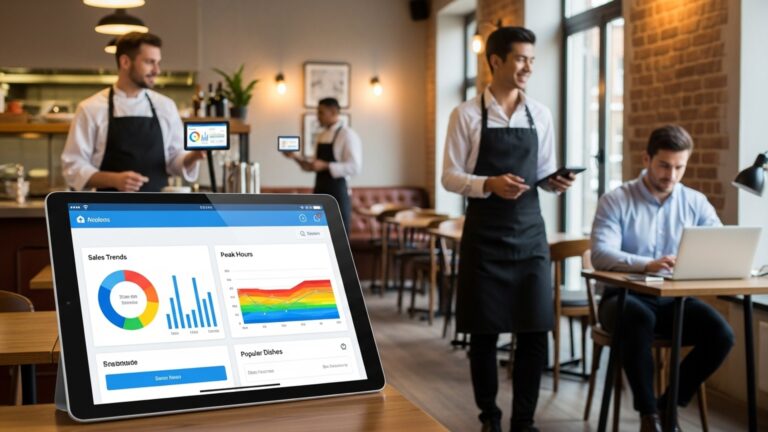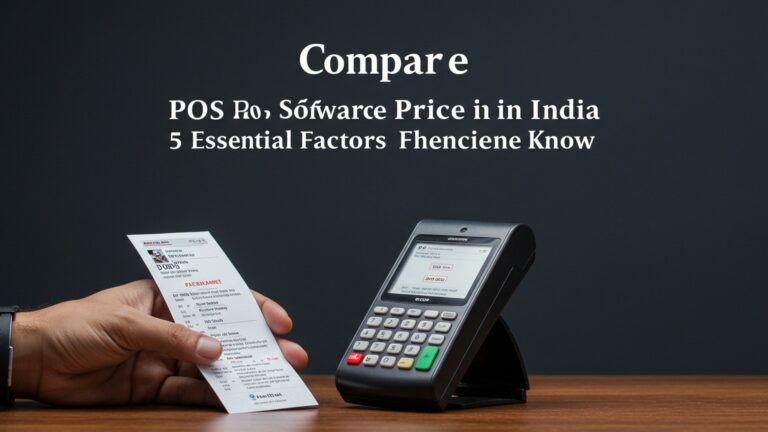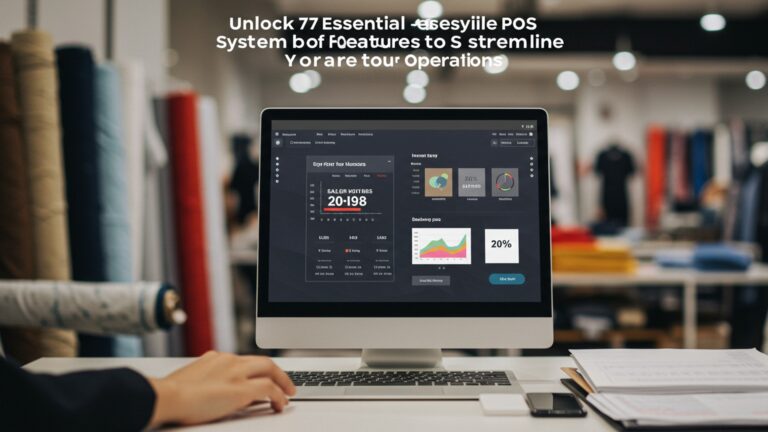Learn 7 Ways Restaurant POS Software Boosts Your Business Profits
In today’s intensely competitive culinary landscape, where razor-thin margins and escalating operational costs challenge even established eateries, merely processing orders no longer suffices. Modern Restaurant POS software transcends basic transaction management, evolving into a critical operational intelligence hub. It empowers restaurateurs to combat prevalent issues like inventory shrinkage, optimize staff deployment amidst labor shortages. deliver the seamless, personalized guest experiences diners now expect, particularly with the surge in QR code menus and mobile payment adoption. By centralizing data from front-of-house to kitchen, advanced POS systems provide actionable insights, transforming raw sales figures into strategic tools that directly influence profitability and drive sustained growth.
1. Streamlined Operations and Reduced Errors
One of the most immediate and impactful ways Restaurant POS software boosts profits is by fundamentally streamlining daily operations. Traditional methods of order taking, billing. kitchen communication are prone to human error, which can lead to wasted food, customer dissatisfaction. lost revenue. A robust POS system automates many of these processes, creating a smoother workflow from the front of the house to the back.
How it boosts profits:
- Faster Order Processing
- Reduced Order Errors
- Efficient Table Management
Servers can input orders directly into a handheld device or stationary terminal, which immediately sends them to the kitchen or bar. This eliminates the need for handwritten tickets, reducing confusion and speeding up service times. Faster service means higher table turnover, allowing more customers to be served in a given period.
Digital order entry minimizes misinterpretations of handwriting or verbal mistakes. When a customer orders a “no onion” burger, it’s clearly communicated to the kitchen via a Kitchen Display System (KDS), drastically cutting down on remakes and food waste. A study by Toast found that restaurants using POS systems reported a significant decrease in order errors compared to those using manual methods.
Many Restaurant POS software solutions include features for tracking table status (occupied, vacant, waiting for food) and managing reservations. This optimizes seating arrangements, reduces customer wait times. ensures efficient use of dining space.
Real-world application:
Consider a bustling diner during lunchtime. Without a POS, a server might scribble down an order, carry it to the kitchen. then go to the register to ring it up. With a modern Restaurant POS software, the server inputs the order at the table, it appears instantly on the KDS for the cooks. the bill can be generated with a tap. This efficiency means the server can manage more tables. customers receive their food quicker and more accurately, leading to better reviews and repeat business.
2. Enhanced Inventory Management and Waste Reduction
Food costs are a significant expense for any restaurant. inefficient inventory management can lead to substantial losses through spoilage, over-ordering, or even theft. Restaurant POS software provides powerful tools to gain granular control over your inventory, directly impacting your bottom line.
How it boosts profits:
- Real-time Inventory Tracking
- Waste Reduction
- Supplier Management and Cost Control
- Recipe Management
Every sale processed through the POS system can automatically deduct ingredients from your inventory. This provides an accurate, real-time snapshot of what you have on hand, preventing stockouts of popular items and overstocking of slow-moving ones.
By accurately tracking ingredient usage, a POS system helps identify waste patterns. If a particular dish consistently results in excess ingredients, you can adjust portion sizes or recipes. Moreover, knowing exactly what’s in stock reduces spoilage because you’re not ordering more than you need.
Many advanced Restaurant POS software systems allow you to track supplier details, compare prices. manage purchase orders. This enables you to negotiate better deals and ensure you’re always getting the best value for your ingredients.
Inputting recipes into the POS system allows for precise cost calculations per dish. This ensures accurate pricing and helps identify dishes with low-profit margins that might need adjustment.
Real-world application:
Imagine a pizzeria. A traditional system might involve manually counting cheese blocks and pepperoni sticks. With Restaurant POS software, every pizza sold automatically reduces the digital count of its ingredients. If the system alerts the manager that pepperoni is running low, they can order just enough to last until the next delivery, avoiding excess stock that could expire or be wasted if sales dip. This proactive approach to inventory saves hundreds, if not thousands, of dollars annually.
3. Improved Customer Experience and Loyalty
A positive customer experience is paramount for repeat business and positive word-of-mouth marketing. Restaurant POS software plays a crucial role in enhancing this experience and fostering customer loyalty, which directly translates to increased profits over time.
How it boosts profits:
- Personalized Service
- Loyalty Programs
- Faster and More Accurate Billing
- Online Ordering and Delivery Integration
Advanced POS systems can store customer preferences, order history. even dietary restrictions. When a returning customer dines, staff can access this details to offer personalized recommendations or recall their favorite drink, creating a memorable and appreciated experience.
Many Restaurant POS software solutions integrate seamlessly with loyalty programs. Customers can earn points, receive discounts, or get special offers based on their spending. These programs incentivize repeat visits, turning one-time diners into regular patrons.
With integrated payment processing, customers can pay quickly and conveniently, often right at their table with handheld POS devices. This reduces wait times for bills and ensures accurate charges, preventing disputes and enhancing satisfaction.
Modern POS systems often connect with online ordering platforms and third-party delivery services, expanding your reach and making it easier for customers to enjoy your food wherever they are. This opens up new revenue streams and caters to evolving customer preferences.
Real-world application:
A coffee shop using a Restaurant POS software can track a customer’s usual order (e. g. , “Latte with oat milk and an extra shot”). When that customer returns, the barista can greet them by name and confirm their regular order, making them feel valued. Moreover, the POS can automatically apply loyalty points or a “buy 10, get 1 free” promotion, encouraging them to choose this coffee shop over competitors, thereby securing consistent sales.
4. Data-Driven Decision Making
Gone are the days of making business decisions based purely on gut feelings. Restaurant POS software collects a wealth of data that, when analyzed, provides invaluable insights into your business’s performance, enabling you to make informed decisions that directly boost profitability.
How it boosts profits:
- Sales Reports and Trends
- Menu Engineering
- Staff Performance Analysis
- Labor Cost Optimization
A POS system can generate detailed reports on sales by hour, day, week, or month. You can see which menu items are bestsellers, which are slow-moving. identify peak dining times. This data helps optimize menu offerings, promotions. staffing schedules.
By analyzing sales data against ingredient costs, you can identify high-profit, high-popularity dishes (“stars”). those that are costing you money (“dogs”). This allows you to adjust pricing, promote profitable items, or remove underperforming ones.
Some POS systems can track individual server sales, average check size. tip percentages. This data can be used for performance reviews, identifying top performers. providing targeted training to improve overall service efficiency and upselling techniques.
By understanding peak hours and staffing needs through sales data, managers can create more efficient schedules, reducing unnecessary labor costs during slow periods while ensuring adequate staffing during busy times to maintain service quality.
Real-world application:
A restaurant owner reviews their Restaurant POS software’s daily sales report and notices that their “Signature Pasta” dish consistently sells well but has a relatively low-profit margin due to an expensive imported ingredient. Simultaneously, a simpler, less popular “Vegetable Stir-fry” has an excellent profit margin. Based on this data, the owner might experiment with a slightly revised, more cost-effective recipe for the pasta or launch a promotional campaign for the stir-fry, aiming to increase its popularity and leverage its high-profit potential. This analytical approach directly informs strategic decisions that enhance profitability.
5. Reduced Labor Costs and Increased Efficiency
Labor is often the largest operating expense for restaurants. While Restaurant POS software doesn’t replace staff, it significantly enhances their efficiency and reduces the need for manual, time-consuming tasks, leading to substantial labor cost savings.
How it boosts profits:
- Automated Time Tracking
- Streamlined Training
- Self-Service Options
- Efficient Workflow for Staff
Integrated time clock features within the POS system ensure accurate recording of employee work hours, eliminating manual punch cards and reducing payroll errors. This also helps in enforcing breaks and preventing unauthorized overtime.
Modern POS interfaces are often intuitive and user-friendly, reducing the training time required for new staff members. Less training time means staff become productive faster. management can focus on other critical tasks.
Some advanced Restaurant POS software includes customer-facing kiosks or QR code ordering systems. These allow customers to browse menus, place orders. even pay without direct server interaction, potentially reducing the number of staff needed during certain shifts.
By automating order routing, payment processing. inventory updates, staff spend less time on administrative tasks and more time on serving customers, upselling. ensuring a positive dining experience.
Real-world application:
Consider a fast-casual restaurant. Before implementing a Restaurant POS software, staff might spend valuable minutes taking orders at the counter, then manually relaying them to the kitchen. finally processing cash or card payments. With a POS system, customers can use a self-ordering kiosk, or a single staff member can efficiently take orders and process payments at a terminal. The orders go directly to a KDS. This automation means fewer staff are needed for order taking and processing, allowing the existing team to focus on food preparation and customer service, ultimately reducing overall labor expenditure while maintaining service speed.
6. Prevention of Theft and Fraud
Unfortunately, internal theft and fraud can be a silent drain on a restaurant’s profits. This can range from unauthorized discounts to cash skimming or giving away free items. Restaurant POS software provides a robust system of checks and balances that significantly deters and detects such activities.
How it boosts profits:
- Transaction Tracking
- User Permissions
- Cash Accountability
- Void and Discount Tracking
Every single transaction, including sales, refunds, voids. discounts, is meticulously recorded in the POS system. This creates a clear digital trail, making it difficult for employees to manipulate sales data without detection.
POS systems allow managers to set specific access levels for different staff roles. For example, only managers might have the authority to process voids, apply discounts, or open the cash drawer without a sale. This limits opportunities for unauthorized actions.
Integrated cash management features, including daily cash reconciliation reports, make it easier to track discrepancies between expected and actual cash in the drawer, holding staff accountable.
The system logs who performed a void or applied a discount, along with the reason. Frequent or unexplained voids/discounts by a specific employee can flag potential issues for management investigation.
Real-world application:
A restaurant manager notices a pattern of high “voided item” reports from one particular server, often occurring during busy shifts. By reviewing the Restaurant POS software’s detailed transaction log, the manager can see exactly which items were voided, when. by whom. This data allows for a direct conversation with the employee, or if fraud is suspected, provides concrete evidence for disciplinary action. Without the detailed audit trail provided by the POS, such patterns might go unnoticed, leading to continuous financial leakage.
7. Increased Sales Opportunities and Revenue Streams
Beyond simply processing transactions, modern Restaurant POS software empowers businesses to actively generate new sales and expand their revenue streams, moving beyond traditional dine-in services.
How it boosts profits:
- Online Ordering Integration
- Upselling and Cross-selling Prompts
- Gift Card Programs
- Dynamic Pricing and Promotions
Many POS systems offer integrated online ordering platforms or seamless connections with popular third-party delivery services (e. g. , DoorDash, Uber Eats). This allows restaurants to reach a broader customer base and tap into the lucrative takeout and delivery market, significantly increasing sales volume.
During the order entry process, a smart Restaurant POS software can prompt servers with suggestions for upselling (e. g. , “Would you like to add chicken to your salad?”) or cross-selling (e. g. , “Can I get you a drink with that?”). These subtle nudges can significantly increase the average check size.
POS systems often support integrated gift card sales and redemption. Gift cards bring in immediate revenue and often lead to customers spending more than the card’s value, effectively acting as pre-paid sales that attract new customers.
With the data collected, a POS system can help implement dynamic pricing strategies (e. g. , happy hour discounts during slow periods) or run targeted promotions (e. g. , BOGO offers on specific days), stimulating demand and boosting sales when needed.
Real-world application:
A small cafe wants to increase its evening business. By integrating its Restaurant POS software with an online ordering platform, they start offering dinner takeout. The POS system manages these orders alongside dine-in ones, ensuring smooth kitchen operations. Also, the POS setup prompts staff to ask “Would you like a pastry with your coffee?” during morning rushes, increasing average transaction value. Through these features, the cafe effectively expands its operational hours and customer reach, directly leading to a noticeable increase in overall revenue that wouldn’t have been possible with a manual system.
Conclusion
The journey to enhanced restaurant profitability undeniably hinges on adopting the right POS software. I’ve personally seen how a well-implemented system, like one streamlining inventory to prevent the costly waste of fresh produce or empowering staff with intuitive order management during peak rushes, transforms operations. It’s not just about processing transactions; it’s about making every decision data-driven, paving the way for sustainable growth. Beyond the immediate gains, consider the future: integrated online ordering and dynamic QR code menu functionalities are no longer luxuries but essential tools, directly impacting customer satisfaction and revenue streams in today’s digital-first landscape. My personal tip? Don’t just implement; optimize. Regularly review your POS reports, identifying trends in customer preferences or slow-moving items to refine your menu and marketing. This proactive approach turns raw data into tangible profit. The restaurant industry is dynamic. staying competitive means embracing technological advancements. Investing in a robust POS system isn’t merely an expense; it’s an investment in efficiency, customer loyalty. ultimately, a more profitable future for your establishment. Take that crucial step today and watch your business thrive. [Explore further POS innovations here](https://www. restauranttechinsights. com/pos-trends).
More Articles
How to Choose the Best POS System for Your Restaurant
Mastering Inventory Management with Your POS
Boosting Customer Loyalty with Integrated POS Features
Understanding POS Reports for Smarter Business Decisions
Seamless Online Ordering: A POS Essential
FAQs
How does restaurant POS software actually help my business make more money?
It helps in several key ways, like speeding up your service, drastically cutting down on order and billing errors, managing your inventory more effectively. giving you clear insights into what’s selling best. All these factors lead to happier customers, less waste. ultimately, a healthier bottom line.
Can a POS system really make my staff faster and reduce mistakes during service?
Absolutely! With a good POS, orders go straight to the kitchen digitally, which eliminates handwritten errors and miscommunications. Your staff can process orders and payments much quicker, meaning you turn tables faster and ensure every bill is accurate, boosting efficiency and customer satisfaction.
How does managing inventory through a POS boost my profits?
By tracking every ingredient and menu item, a POS helps you prevent over-ordering, reduce spoilage. even spot potential theft. You’ll know exactly what you have, what you need. what’s being used, saving you significant money on food costs and improving your profit margins.
What kind of data or insights can I get from the software to increase sales?
A modern POS provides detailed reports on your best-selling items, slowest movers, peak business hours. even individual server performance. This valuable data allows you to optimize your menu, create targeted promotions. staff your restaurant more efficiently, all of which directly lead to increased sales.
Does this software help with customer loyalty programs to get repeat business?
Yes, many advanced POS systems integrate loyalty programs directly. You can easily track customer preferences, offer personalized discounts or rewards. encourage repeat visits. Building a loyal customer base is crucial for long-term profitability. a POS makes it simple.
Can a POS help me manage online orders and integrate with delivery services to expand my reach?
Definitely! Many POS solutions seamlessly integrate with popular online ordering platforms and third-party delivery services. This expands your revenue streams beyond your dining room, allowing you to tap into the growing takeout and delivery market with minimal hassle, reaching more customers and increasing sales.
How can a POS help me manage my team and save on labor costs?
POS systems often include features for employee time tracking, shift scheduling. even sales performance reports per staff member. This helps you optimize staffing levels during busy and slow periods, reduce unnecessary overtime. ensure your team is working as efficiently as possible, directly impacting your labor expenses.





